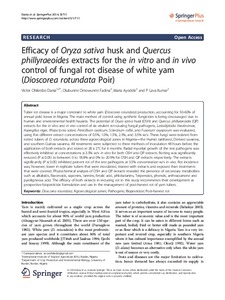| dc.identifier.citation | Dania, V., Fadina, O., Ayodele, M. & Kumar, P.L. (2014). Efficacy of oryza sativa husk and quercus phillyraeoides extracts for the in vitro and in vivo control of fungal rot disease of white yam (Dioscorea rotundata Poir). SpringerPlus, 3(1), 711. |
| dc.description.abstract | Tuber rot disease is a major constraint to white yam (Dioscorea rotundata) production, accounting for 50-60% of annual yield losses in Nigeria. The main method of control using synthetic fungicides is being discouraged due to human and environmental health hazards. The potential of Oryza sativa husk (OSH) and Quercus phillyraeoides (QP) extracts for the in vitro and in vivo control of six virulent rot-causing fungal pathogens, Lasiodiplodia theobromae, Aspergillus niger, Rhizoctonia solani, Penicillium oxalicum, Sclerotium rolfsii, and Fusarium oxysporum was evaluated, using five different extract concentrations of 0.5%, 1.0%, 1.5%, 2.5%, and 3.5% w/v. These fungi were isolated from rotted tubers of D. rotundata, across three agroecological zones in Nigeria?the Humid rainforest, Derived savanna, and southern Guinea savanna. All treatments were subjected to three methods of inoculation 48 hours before the application of both extracts and stored at 28 ± 2°C for 6 months. Radial mycelial growth of the test pathogens was effectively inhibited at concentrations ? 3.5% w/v in vitro for both OSH and QP extracts. Rotting was significantly reduced (P ? 0.05) to between 0 to 18.8% and 0% to 20.9% for OSH and QP extracts respectively. The extracts significantly (P ? 0.05) inhibited percent rot of the test pathogens at 3.5% concentration w/v in vivo. Rot incidence was, however, lower in replicate tubers that were inoculated, treated with extracts and exposed than treatments that were covered. Phytochemical analysis of OSH and QP extracts revealed the presence of secondary metabolites such as alkaloids, flavonoids, saponins, tannins, ferulic acid, phlobatanins, Terpenoids, phenols, anthraquinone and pyroligneous acid. The efficacy of both extracts in reducing rot in this study recommends their development as prospective biopesticide formulation and use in the management of post-harvest rot of yam tubers. |

